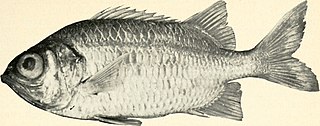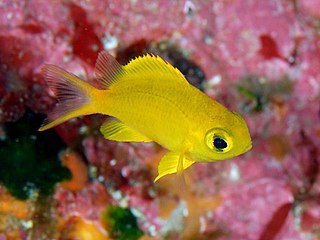
The New Zealand demoiselle, Chromis dispilus, is a damselfish of the genus Chromis, found between North Cape and East Cape of the North Island of New Zealand to depths of about 60 metres, off rocky coasts. Its length is between 15 and 20 cm. Males are highly territorial as they defend their nesting area from other males and other species. These aggressive fish defend their eggs laid by their female counterpart. Spawning occurs between the months of December and March. The New Zealand demoiselle's territory and nesting grounds of this fish are usually the largest in a medium population density. Like most territorial fish they tend to spawn more in higher densities of the same species compared to lower densities. Aggression levels tend to be higher amount higher densities of the same species and lower levels in smaller densities. Aggression also tends to be higher during spawning then during egg defending. Elevated plasma levels of androgen testosterone and 11-Ketotesterone are associated with the heighten levels of aggression shown by the males.

The masked hamlet is a species of marine ray-finned fish, a sea bass from the subfamily Serraninae which is part of the family Serranidae, which also includes the groupers and anthias. This species is found in the western Atlantic Ocean in the Caribbean Sea and has been recorded from the coast of Central America from Quintana Roo in Mexico to Bocas del Toro in Panama and from Jamaica to Puerto Rico, as well as in the Turks and Caicos and the Cayman Islands. Its specific name refers to Providencia Island, Colombia where the type was collected. It was also recorded from other islands in the Archipelago of San Andrés, Providencia and Santa Catalina. They are a unique species in the Hypoplectrus genus, defined by their unique color morph. Their behavior is largely similar to that of other hamlets, especially in their diet and egg-trading spawning patterns.

Chromis chromis, the damselfish or Mediterranean chromis, is a small species of ray-finned fish of the family Pomacentridae from the Eastern Atlantic and Mediterranean.
Xenocypris yunnanensis, the Kunming nase, is a species of ray-finned fish in the genus Xenocypris. It is endemic to Lake Dianchi in Yunnan Province, China. The species started to decline in the 1970s and has not been caught in the lake after two specimens were collected in 1985; it may be extinct. Its demise is likely due to introduced fish species, grass carp. It was also impacted by over-fishing and pollution. They grow to a maximum length of 23 cm. They are dark grayish with a silvery white belly, gray dorsal fin, reddish anal fin and orange red caudal fin. They have a rounded belly, blunt snout, eyes on the lateral of their heads, small and transverse mouth.

Pycnochromis margaritifer, known commonly as the bicolor chromis, is a species of marine fish in the family Pomacentridae. The species was reclassified as Pycnochromis margaritifer in 2021, and is still listed under the former name Chromis margaritifer in some places.

The Azores chromis or Atlantic chromis is a species of damselfish from the family Pomacentridae which is found in the Macaronesian Islands of the temperate eastern Atlantic Ocean and has been reported from coastal regions of western Africa.

Kyphosus cinerascens is a species of marine ray-finned fish. It is a sea chub from the family Kyphosidae. Kyphosus Cinerascens has 11 dorsal fins and 12 anal fins. Kyphosus cinerascens are widely distributed in the Indo-Pacific region. The Kyphosus cinerascens has a strict diet on phaeophytes, chlorophytes, and rhodophytes, making them herbivores.

Plectrypops lima, the shy soldier, is a species of soldierfish from the genus Plectrypops. It can be found in the Indo-Pacific region from East Africa to Chile, north to Japan and the Ogasawara Islands. It is an uncommon inhabitant of reefs. During the day, it hides in deep crevices and comes out at night. It is solitary and cryptic. It feeds on small crustaceans, crustacean larvae and small fishes.

Myripristis chryseres, the yellowfin soldierfish, is a nocturnal species of soldierfish from the genus Myripristis. It is found in the Indo-Pacific region, from Natal, South Africa to Samoa, Hawaii and the Tuamotu Islands, north to south Japan and the Ogasawara Islands, and south to Queensland, Australia It inhabits steep outer reef slopes and is often seen with Coelacanths at Ngazidja Island. It feeds on zooplankton and can be seen either solitary or in groups.
Myripristis formosa is a species of soldierfish belonging to the genus Myripristis. It is endemic to Taiwan in the North-west Pacific Ocean. It is named after the Republic of Formosa, a short-lived republic that existed on Taiwan. It is demersal with a depth range of 15m to 30m.

Myripristis gildi, also known as the Clipperton cardinal soldierfish, is a species of soldierfish belonging to the genus Myripristis. First described in 1965 by Greenfield, it is endemic to Clipperton Island in the Eastern Pacific Ocean. Its total length reaches at least 21.4cm.

Myripristis pralinia, the scarlet soldierfish, is a nocturnal species of soldierfish from the genus Myripristis. It can be found in the Indo-Pacific region, from East Africa to the Marquesas Islands and the Gambier Islands, north to the Ryukyu Islands and south to New Caledonia. It can also be found on the Marshall Islands and the Mariana Islands. It can be found in small, loose groups in caves or under ledges in reef flats, lagoons and outer reef slopes. It feeds on plankton.
Myripristis tiki, the tiki squirrelfish, is a species of soldierfish belonging to the genus Myripristis. It can be found in the Pacific Ocean in the Cook Islands, Tonga, Pitcairn, the Cook Islands and Easter Island.

Chromis agilis, the agile chromis, is a species of damselfish belonging to the genus Chromis. It can be found in the Indian Ocean, from the Maldives, the Chagos Archipelago, Seychelles, Madagascar, the Comoro Islands, and along the East African coastline between Shimoni in Kenya and Bazaruto in Mozambique. It inhabits clear lagoons and seaward reefs, usually in loose aggregations near caves and ledges. It is commonly found over branching corals and leeward coasts. It is oviparous, and the males of the species guard and aerate the eggs.

Chromis albomaculata, the white-spotted chromis, is a diurnal species of damselfish belonging to the genus Chromis. It can be found in the North Western Pacific Ocean in the Izu Islands, Okinawa Island, the Ogasawara Islands and in Taiwan. It inhabits steep slopes and rocky bottoms on offshore reefs. It is oviparous, and the males of the species guard and aerate the eggs.

Chromis alpha, the yellow-speckled chromis, is a diurnal species of damselfish belonging to the genus Chromis. It can be found in the Indo-Pacific region from Christmas Island to the Society Islands, north to the Mariana Islands, south to New Caledonia, through Micronesia. It inhabits clear lagoons and seaward reefs appearing singly or in loose aggregations near caves or ledges. It is commonly found over branching corals and leeward coasts, and it feeds on plankton. It is oviparous, and the males of the species guard and aerate the eggs.
Gobiopterus birtwistlei is a species of goby belonging to the genus Gobiopterus. It is endemic to Singapore in the Western Pacific Ocean. According to Fishbase, it is currently the only described species of freshwater fish endemic to Singapore and is one of two described species of fish endemic to Singapore. It is demersal.

Chromis chrysura, the stout chromis, is a diurnal species of damselfish belonging to the genus Chromis. Several isolated populations of the species have been found. The first is in Taiwan, the Ryukyu Islands and Southern Japan, the second one lies in the Coral Sea in New Caledonia, Vanuatu, Fiji, and Eastern Australia, and the third one lies in the Western Indian Ocean in Mauritius and Réunion. It is also found in the Philippines and is possibly found in India. It inhabits outer coral or rocky reefs. It usually forms large aggregations in shallow waters and feeds on zooplankton. It is oviparous, and the males of the species guard and aerate the eggs.

Chromis crusma, the valaparaiso chromis, is a species of damselfish belonging to the genus Chromis. It can be found in the South-Eastern Pacific Ocean, from Cabo Blanco, Peru to Talcahuano, Chile. It is oviparous, and the males of the species guard and aerate the eggs.

Chromis albicauda, the white-caudal chromis, is a species of damselfish belonging to the genus Chromis. It can be found in the Western Pacific Ocean along the northern and western shores of Nusa Penida, Indonesia and the southern Japanese seas. It inhabits areas of cool upwelling. It typically forms aggregations, feeding high in the water column on zooplankton when currents are strong. It is oviparous, and the males of the species guard and aerate the eggs.

















